|
|
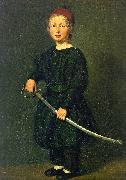 |
Christian Albrecht Jensen
|
|
1792-1870
Danish
Christian Albrecht Jensen Galleries
1792-1870
Danish
Christian Albrecht Jensen Galleries
was a Danish painter, born in Bredstedt, Nordfriesland. In 1818, he traveled to Rome, and met the sculptor Bertel Thorvaldsen. His work is representative of the Golden Age of Danish Painting.
|
|
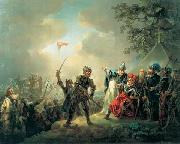 |
Christian August Lorentzen
|
|
(10 August 1749 - 8 May 1828) was a Danish painter. He was the instructor of Martinus Rørbye.
Christian August Lorentzen was born on 10 August 1749 as the son of a watchmaker. He arrived in Copenhagen around 1771 where he frequented the Royal Academy of Fine Arts but it is unclear whether he received formal training.From 1779 to 1782 he want abroad to develop his skills, visiting the Netherlands, Antwerp and Paris where he copied old masters. In 1792 he traveled to Norway to paint prospects.
In a number of painting, such as Slaget på Reden (1801, Danish Museum of National History and Den rædsomste nat (1807, Danish National Gallery, he documented key events from the English Wars between 1801 and 1814. Later in his career he mainly painted portraits, landscapes and scenes from Ludvig Holberg's comedies.
As a professor at the Royal Academy in Copenhagen from 1803 and until his death in 1828, he exercisized great influence on the next generation of painters such as Martinus Rørbye among others. |
|
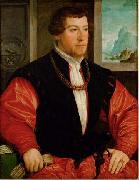 |
Christoph Amberger
|
|
(c. 1505 --1562) was a painter of Nernberg in the 16th century, a disciple of Hans Holbein, his principal work being the history of Joseph in twelve pictures.
Amberger travelled to Northern Italy and Venice between 1525 and 1527. He died in Augsburg.
|
|
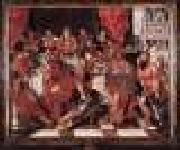 |
CLAEISSENS, Antoon
|
|
Flemish painter (b. ca. 1538, Brugge, d. 1613, Brugge).
Flemish painter and draughtsman. In 1587 he was working in Rome with the Brussels painter Frans van de Kasteele. That he subsequently lived in Brussels is confirmed by documentary evidence and by his status as court painter to the governors of the southern Netherlands. Stylistically, de Clerck's work (both paintings and drawings) is close to that of the Antwerp late Mannerist Marten de Vos, traditionally thought to have been his teacher, but it is possible that he was apprenticed to Joos van Winghe in Italy. He was later a member of the Brussels painters' guild, where from 1601 to 1611 Jan van Overstraeten was registered as his pupil. It was in 1594 that de Clerck was appointed court painter in Brussels, first to Archduke Ernest. In 1596, after the Archduke's death, his brother Emperor Rudolf II arranged for de Clerck to stay on as court painter in the service of the new Archdukes, Albert and Isabella. In 1609 de Clerck and Wenceslas Cobergher were commissioned to decorate the ceiling of the oratorium in the archducal palace in Brussels |
|
|
|
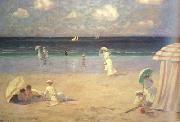 |
Clarence a gagnon
|
|
Canadian Painter, 1881-1942
was a Quebecois painter. A native of Montreal, he studied at the Art Association of Montreal in 1897. Early in life, his mother had encouraged him to learn drawing and painting, but his father wanted him to become a businessman. Desiring to improve his knowledge about art, he went to the Academie Julian, Paris, and studied under Jean-Paul Laurens from 1904 to 1905. He then lived in Baie-Saint-Paul, where he produced many paintings depicting nature and the Canadian people. He invented a new kind of winter landscape that consisted of mountains, valleys, sharp contrasts, vivid colours, and sinuous lines. He became a member of the Royal Academy of the Arts in 1910. Gagnon took a trip to Venice, Rouen, Saint-Malo and the Laurentians to paint landscapes. He illustrated the pages of the novel Maria Chapdelaine by Louis Hemon. As well, he was the illustrator for Louis-Frederic Rouquette in 1929 in the white silence. He lived in France from 1924 to 1936. Gagnon opened modernity painting within Canada. He died in 1942. One of his disciples is the painter Rene Richard. |
|
|
|
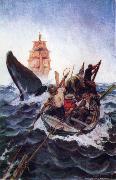 |
Clifford Warren Ashley
|
|
Author, Sailor, and Artist
American
1881-1947
was an American author, sailor, and artist. He is perhaps most famous for The Ashley Book of Knots, an encyclopedic reference manual with directions for and illustrations of thousands of knots. He invented the Ashley's stopper knot. Ashley also wrote The Yankee Whaler, a study of sperm whale hunters in New England in the late 18th century and early 19th century. He was born in New Bedford, |
|
 |
COORTE, Adriaen
|
|
Dutch Baroque Era Painter, ca.1660-1707
Dutch painter. He painted mainly small still-lifes, but contrary to the contemporary fashion for increasingly complicated representations of flowers and fruit, he preferred to paint single objects arranged as simply as possible. Coorte's subjects were generally fruit or vegetables, sometimes shells and, more rarely, flowers or vanitas arrangements. These are generally arranged on a stone plinth or slab, often with a crack or groove on the front edge. In the larger paintings the composition is sometimes enclosed in a niche |
|
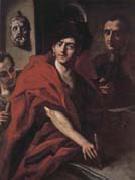 |
Cosmas Damian asam
|
|
1686-1739
Tegernsee, Bavaria died April 29, 1750, Mannheim, Palatinate) Bavarian architects and decorators. After studying in Rome (1711 C 13), Cosmas Damian became a prolific fresco painter, and his brother, Egid Quirin, became a sculptor and stuccoist. They developed the effects of dramatic lighting and illusionism originated by Gian Lorenzo Bernini and Andrea Pozzo. Working as a team, they produced magnificent illusionistic decoration in ecclesiastical buildings, combining dramatic lighting and colour. Their works are notable for their profound and dramatic intensity of religious feeling. The brothers became the principal late Baroque exponents of illusionist decoration in religious architecture. Their most notable collaboration is the church of St. John Nepomuk in Munich |
|
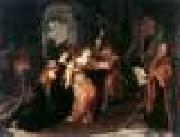 |
COYPEL, Antoine
|
|
French Baroque Era Painter, 1661-1722
director of the French Royal Academy and principal painter of Louis XV. He illustrated many literary works, including editions of Moliere's plays, and was himself a prolific dramatist. Coypel wrote one fairy tale, Agla ou Nabotine (Agla or Little One?), published posthumously in 1779. Coypel weaves several traditional fairy tale motifs into the story of a benevolent fairy who tests the kindness and sincerity of an ugly little girl whose virtue is eventually rewarded with beauty and the love of a handsome young man.
|
|
|
|
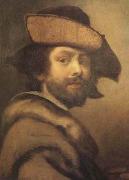 |
Cristofano Allori
|
|
Italian Baroque Era Painter, 1577-1621
was an Italian portrait painter of the late Florentine Mannerist school. Allori was born at Florence and received his first lessons in painting from his father, Alessandro Allori, but becoming dissatisfied with the hard anatomical drawing and cold coloring of the latter, he entered the studio of Gregorio Pagani (1558-1605) who was one of the leaders of the late Florentine school, which sought to unite the rich coloring of the Venetians with the Florentine attention to drawing. Allori also appears to have worked under Cigoli. His pictures are distinguished by their close adherence to nature and the delicacy and technical perfection of their execution. His technical skill is shown by the fact that several copies he made of Correggio's works were thought to be duplicates by Correggio himself. His extreme fastidiousness limited the number of his works. Several specimens are to be seen at Florence and elsewhere. The finest of his works is his Judith with the Head of Holofernes. It exists in two copies in the Pitti Palace in Florence and in the Queen's Gallery in London. |
|
|
|
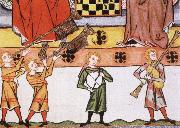 |
dante alighieri
|
|
Born: 1265
Birthplace: Florence, Italy
Died: September 1321 (Malaria)
Best Known As: The author of The Divine Comedy
|
|
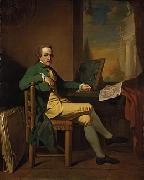 |
David Allan
|
|
13 February 1744 C 6 August 1796) was a Scottish painter, best known for historical subjects.
He was born at Alloa in central Scotland. On leaving Foulis's academy of painting at Glasgow (1762), after seven years' successful study, he obtained the patronage of Lord Cathcart and of Erskine of Mar, on whose estate he had been born. Erskine made it possible for him to travel to Rome (1764), where he remained for several years engaged principally in copying the old masters.
Among the original works which he then painted was the "Origin of Portraiture", now in the National Gallery at Edinburgh--representing a Corinthian maid drawing her lover's shadow--well known through Domenico Cunego's excellent engraving. This won him the gold medal given by the Academy of St Luke in the year 1773 for the best specimen of historical composition. |
|
|
|
 |
Davies Arthur Bowen
|
|
American Symbolist Painter, printmaker and tapestry designer , b.1862 d.1928
American painter and illustrator. He first trained as an architectural draughtsman at the Academy of Design, Chicago (1878). After studying briefly at the Art Institute of Chicago, he went to New York, where he attended the Gotham School and the Art Students League (1886-8). By 1887 he was working as an illustrator for Century magazine. A realist landscape painter in the 19th-century academic tradition, he was influenced by the painters of the Hudson River school and particularly by the luminist, dream-like landscapes of George Inness. |
|
|
|
|
|
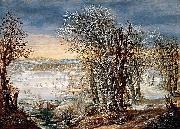 |
Denis van Alsloot
|
|
(Dutch: Denijs van Alsloot) (c. 1570, Mechelen - c. 1626) was a Flemish Baroque painter.
He initially painted using the style of Gillis van Coninxloo, but after 1610 gradually developed a style of his own. This style can be seen in paintings such as The feast of the Ommegang (Museo del Prado, Madrid) and Procession to Mary at the Zavel in Brussels (Victoria and Albert Museum, London).
At the beginning of the 17th century, in either 1600 or 1606, his career rose when he served as court painter to Albert and Isabella.
Hendrick de Clerck sometimes painted the people (Dutch: stoffering or stoffage) in his landscape works.
Van Alsloot's work can be regarded as a precursor to modern Landscape art.
|
|
|
|
|
|
 |
Dirk van der Aa
|
|
Dirk van der Aa , 1731 -- February 23, 1809.
He was born in The Hague, and first apprenticed to Johann Heinrich Keller, and then to Gerrit Mes with whom he would later start a workshop; they specialized in grisaille decorative paintings. He counted Evert Morel, Cornelis Kuipers, Johan Christiaan Roedig and Andries van der Aa amongst his students. He died in his home city of The Hague. |
|
|
|
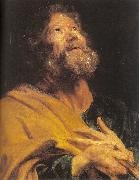 |
Dyck, Anthony van
|
|
Flemish Baroque Era Painter, 1599-1641
Flemish painter and draughtsman, active also in Italy and England. He was the leading Flemish painter after Rubens in the first half of the 17th century and in the 18th century was often considered no less than his match. A number of van Dyck's studies in oil of characterful heads were included in Rubens's estate inventory in 1640, where they were distinguished neither in quality nor in purpose from those stocked by the older master. Although frustrated as a designer of tapestry and, with an almost solitary exception, as a deviser of palatial decoration, van Dyck succeeded brilliantly as an etcher. He was also skilled at organizing reproductive engravers in Antwerp to publish his works, in particular The Iconography (c. 1632-44), comprising scores of contemporary etched and engraved portraits, eventually numbering 100, by which election he revived the Renaissance tradition of promoting images of uomini illustri. His fame as a portrait painter in the cities of the southern Netherlands, as well as in London, Genoa, Rome and Palermo, has never been outshone; and from at least the early 18th century his full-length portraits were especially prized in Genoese, British and Flemish houses, |
|
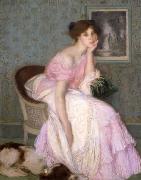 |
Edmond Aman-Jean
|
|
(1858 - 1936) was a French symbolist painter, who founded the Salon des Tuileries. It is also noted that he was a friend of Georges Seurat. |
|
|
|
|
|
|
|
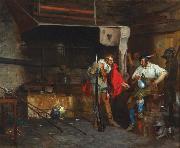 |
Eduardo Zamacois Y Zabala
|
|
Eduardo Zamacois y Zabala (ca. 1841 - 14 January 1871) was a Spanish academic painter who was born in Bilbao, Spain in 1841 or 1842. He moved to Madrid in 1859, where he enrolled in the Real Academia de Bellas Artes de San Fernando and studied with Federico de Madrazo. In 1860, he studied in Paris with Jean-Louis-Ernest Meissonier (1815-1891). He achieved success at the Paris Salon of 1867 with Buffon au 16e siecle.
Zamacois y Zabala is associated with both classicism and anti-clerical art. He is known to have employed the Swiss painter Edouard Castres (1838-1902) as his assistant. He died in Madrid in 1871 at the age of 29.
|
|
 |
Edward Armitage
|
|
(May 20, 1817 - May 24, 1896) was an English Victorian era painter whose work focussed on historical, classical and biblical subjects.
Armitage was born in London to a family of wealthy Yorkshire industrialists, the eldest of seven sons of James Armitage (1793 - 1872) and Anne Elizabeth Armitage nee Rhodes (1788 - 1833), of Farnley Hall, just south of Leeds, Yorkshire. His great-grandfather James (1730 - 1803) bought Farnley Hall from Sir Thomas Danby in 1799 and in 1844 four Armitage brothers, including his father James, founded the Farnley Ironworks, utilising the coal, iron and fireclay on their estate. His brother Thomas Rhodes Armitage (1824 - 1890) founded the Royal National Institute of the Blind.
Armitage was the uncle of Robert Armitage (MP), the great-uncle of Robert Selby Armitage, and first cousin twice removed of Edward Leathley Armitage.
|
|
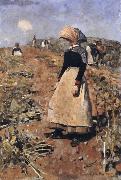 |
Edward Arthur Walton
|
|
British Painter, 1860-1922
He trained at the Staatliche Kunstakademie in Desseldorf (1876-7) and Glasgow School of Art. One of the GLASGOW BOYS, he painted outdoors in the Trossachs and at Crowland, Lincs, with James Guthrie, Joseph Crawhall and George Henry. He also painted in W. Y. Macgregor's life studio in Glasgow. He joined the New English Art Club in 1887 and developed an atmospheric landscape style influenced by plein-air painting and by James McNeill Whistler with whom he was friendly during his stay in London (1894-1904); Autumn Sunshine (1884; U. Glasgow, Hunterian A.G.) is characteristic. Walton was a regular exhibitor from 1880 in both Glasgow, at the Institute of the Fine Arts, and Edinburgh, at the Royal Scottish Academy. He was elected an Associate of the Academy in 1889 and a full member in 1905, taking an active role in its affairs after moving to Edinburgh in 1904. He concentrated after c. 1885 on pastel and on watercolour, which he used notably in his Helensburgh and Kensington scenes of contemporary life. From 1915 he served as President of the Royal Scottish Water Colour Society. Oil was reserved largely for portraits in a Whistlerian style, such as the Artist's Mother. |
|
|
|
|
|
|
|
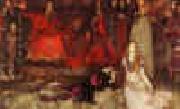 |
Edwin Austin Abbey
|
|
1852-1911
Edwin Austin Abbey Gallery
Edwin Austin Abbey (April 1, 1852 ?C August 1, 1911) was an American artist, illustrator, and painter. He flourished at the beginning of what is now referred to as the "golden age" of illustration, and is best known for his drawings and paintings of Shakespearean and Victorian subjects. His most famous work, The Quest of the Holy Grail, resides in the Boston Public Library.
Abbey was born in Philadelphia, Pennsylvania in 1852. He studied art at the Pennsylvania Academy of the Fine Arts under Christian Schuessele. Abbey began as an illustrator, producing numerous illustrations and sketches for such magazines as Harper's Weekly and Scribner's Magazine. His illustrations began appearing in Harper's Weekly at an early age: before Abbey was twenty years old. Abbey was an illustrator with Harper's Weekly from 1871-1874. He moved to England in 1878 where he was made a full member of the Royal Academy in 1898. In 1902 he was chosen to paint the coronation of King Edward VII. It was the official painting of the occasion and, hence, resides at Buckingham Palace. In 1907 he declined an offer of knighthood in order to retain his U.S. citizenship. Friendly with other expatriate American artists, he summered at Broadway, Worcestershire, England, where he painted and vacationed alongside John Singer Sargent at the home of Francis Davis Millet.
He completed murals for the Boston Public Library in the 1890s. The frieze for the Library was titled "The Quest for the Holy Grail." It took Abbey eleven years to complete this series of murals in his England studio. In 1908-1909, Abbey painted a number of murals and other artworks for the rotunda of the new Pennsylvania State Capitol in Harrisburg, Pennsylvania. His works in that building include allegorical medallions representing Science, Art, Justice, and Religion in the Capitol Rotunda, large lunette murals underneath the Capitol dome, and a number of works in the House Chamber. Unfortunately, Abbey became ill with cancer in 1911 slowing his work. At the time, he was working on the "Reading of the Declaration of Independence Mural" which was later installed in the House Chamber. Abbey was so ill, that his studio assistant, Ernest Board completed the work with little supervision from Abbey. Later in 1911, Abbey died, leaving his commission for the State Capitol of Pennsylvania unfinished. John Singer Sargent, a friend and neighbor of Abbey, and studio assistant Board completed the "Reading of the Declaration of Independence Mural." Abbey's works were installed in the Rotunda and House Chamber. Two rooms from Abbey's commission were left undone, and the remainder of the commission was given to Violet Oakley. Oakley completed the works from start to finish using her own designs.
Abbey was elected to the National Academy of Design and The American Academy of Arts and Letters. In 1937 Yale University became the home for a sizable collection of Abbey's works, the result of a bequest from Abbey's widow. |
|
 |
EERTVELT, Andries van
|
|
Flemish painter (b. 1590, Antwerpen, d. 1652, ?)
Flemish painter. He enrolled as a member of Antwerp's Guild of St Luke in 1609. In 1615 he married Catherine Vlieger (d 1627), after whose death he went to Genoa, where he worked for Cornelis de Wael. By c. 1630 he was back in Antwerp, where he had his portrait painted by Anthony van Dyck (1632; Augsburg, Schaezlerpal.). In 1633 Eertvelt married Elisabeth Boots, probably a daughter of the Antwerp painter Jan Boots (b before 1620). Eertvelt is regarded as the first Flemish marine painter. Over the years his palette and style changed. His first paintings, mostly of ships in storms (e.g. Sea Battle in a Storm; Schwerin, Staatl. Mus.), were painted in greenish-black and brown tones, often using white to highlight the rigging against the dark sea. After his tour of Italy he favoured views of southern harbours, with calm seas painted in soft tones (e.g. Spanish Ships Leaving a Port; Vienna, Ksthist. Mus.). In his day Eertvelt was a man of distinction whose artistic qualities were praised by the poet Cornelis de Bie and whose marine paintings were appreciated abroad, some being exported as far as Seville and Lisbon. |
|
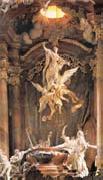 |
Egid Quirin Asam
|
|
German Baroque Era Sculptor, 1692-1750,was a German plasterer and sculptor active during the period of the Late Baroque. Born in Tegernsee, Bavaria, Asam worked mainly together with his brother, the architect and painter Cosmas Damian Asam. Because of this, their common work is often attributed to the Asam Brothers. Asam died in Mannheim. |
|
|
|
 |
ELSHEIMER, Adam
|
|
German Baroque Era Painter, 1578-1610
German painter, printmaker and draughtsman, active in Italy. His small paintings on copper established him after his brief life as the most singular and influential German artist to follow D?rer. Their grand conception in terms of monumental figures and poetic landscape and their meticulous, miniature-like execution were admired by Rubens and came to influence many 17th-century artists, including Rembrandt. Most were produced in Rome after 1600:
|
|
|
|
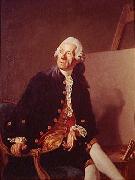 |
Etienne Aubry
|
|
Etienne Aubry, who was born at Versailles in 1746, studied under J. A. Silvestre and Joseph Vien, and soon became noted for his portraits and genre subjects. He exhibited several works of great merit at the Salon; but his life was cut short in its prime in 1781, in which year he had exhibited the 'Parting of Coriolanus from his Wife.' |
|
|
|
|
|
|
|
 |
FALCONE, Aniello
|
|
Italian painter, Naples school (b. 1607, Napoli, d. 1656, Napoli).
Italian painter and draughtsman. He trained briefly with Jusepe de Ribera, the Caravaggesque Spanish painter. He quickly won fame as a specialist in scenes of battle, and his contemporaries nicknamed him the 'oracle' of this genre. Falcone created the 'battle scene without a hero' (Saxl): he showed the battle as a brutal, confused struggle between anonymous troops, without heroes, without defeats and without particular historical incidents. The Battle between Turks and Christians (1621; Paris, Louvre; see fig.) is one of the earliest. The frieze-like composition is elaborately structured, yet the picture is rich in intensely naturalistic, vividly coloured details of armour and weapons and precisely observed expressions of anger and pain. The famous dealer and collector Gaspar Roomer and other Neapolitan collectors commissioned many battle pictures from him, and these were soon introduced throughout Europe. He was especially favoured by Ferrante Spinelli, Prince of Tarsia, who gave Falcone a residence in his palace after 1651. |
|
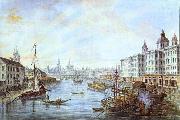 |
Fedor Alekseev
|
|
(c. 1753 ?C November 23, 1824) was an early Russian painter of landscape art.
After training in the Saint Petersburg Imperial Academy of Arts, he spent three years in Venice studying the works of famous French and Italian landscape painters.
Returning to Saint Petersburg to work, his popularity grew over time. In 1800, Emperor Paul of Russia commissioned a series of paintings of Moscow from him.
|
|
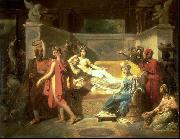 |
Felix Auvray
|
|
a French historical painter, was born at Cambrai in 1800. He was a pupil of Momal in Valenciennes, and afterwards of Gros in Paris. He exhibited in 1824, 'St. Louis a Prisoner,' and in 1827, 'Gautier de Châtillon defending St. Louis against the Saracens,' now in the Museum of Cambrai; 'St. Paul at Athens,' &c. He died in 1833, in his native city.
|
|
|
|
|

